

Pronasal Control

Ask a doctor about a prescription for Pronasal Control

How to use Pronasal Control
Leaflet attached to the packaging: patient information
Pronasal Control, 50 micrograms/dose, nasal spray, suspension
For use in adults
Before using the medicine, read the leaflet carefully and familiarize yourself with the educational materials. This information is available after scanning the QR code with your smartphone and on the website (see section 6.).
Mometasone furoate
Read the leaflet carefully before using the medicine, as it contains important information for the patient.
This medicine should always be used exactly as described in the patient leaflet or as directed by your doctor or pharmacist.
- Keep this leaflet, you may need to read it again.
- If you need advice or additional information, consult your pharmacist.
- If you experience any side effects, including any possible side effects not listed in the leaflet, tell your doctor or pharmacist. See section 4.
- If there is no improvement after 14 days or if you feel worse, consult your doctor.
Table of contents of the leaflet:
- 1. What is Pronasal Control and what is it used for
- 2. Important information before using Pronasal Control
- 3. How to use Pronasal Control
- 4. Possible side effects
- 5. How to store Pronasal Control
- 6. Contents of the packaging and other information
This medicine is suitable only for adults with seasonal allergic rhinitis diagnosed by a doctor.
If the patient is unsure whether they have seasonal allergic rhinitis, they should consult a doctor.
Typical symptoms of seasonal allergic rhinitis include runny nose, sneezing, and nasal congestion, causing a feeling of nasal congestion at certain times of the year.
1. What is Pronasal Control and what is it used for
What is Pronasal Control?
Pronasal Control, 50 micrograms/dose, nasal spray, suspension contains mometasone furoate, which belongs to a group of medicines called corticosteroids. Mometasone furoate should not be confused with anabolic steroids in tablet or injectable form, which are misused by some athletes. Mometasone furoate administered intranasally relieves symptoms of rhinitis (nasal congestion and irritation), sneezing, itching, and feeling of nasal congestion, and reduces nasal discharge.
When is Pronasal Control used?
Pronasal Control is used in adults (over 18 years of age) to treat symptoms of seasonal allergic rhinitis (also known as seasonal allergic rhinitis) after diagnosis by a doctor.
Seasonal allergic rhinitis, which occurs at certain times of the year, is an allergic reaction caused by inhaling pollen from trees, grasses, and other plants, as well as mold and fungal spores. Pronasal Control reduces nasal congestion and irritation and thus relieves symptoms caused by seasonal allergic rhinitis, such as sneezing, itching, feeling of nasal congestion, and reduces nasal discharge.
If there is no improvement or the patient feels worse after 14 days of using the medicine, they should consult their doctor.
2. Important information before using Pronasal Control
When not to use Pronasal Control
- if the patient is allergic to mometasone furoate or any of the other ingredients of this medicine (listed in section 6);
- if the patient has an untreated nasal infection. Using Pronasal Control during an untreated infection in the nasal passages, such as herpes, may worsen the symptoms of the infection. Before using the nasal spray, wait until the infection has cleared up;
- if the patient has recently undergone nasal surgery or nasal injury. Do not use the nasal spray until the wounds have healed.
Warnings and precautions
Before starting treatment with Pronasal Control, discuss it with your doctor or pharmacist.
- if the patient currently has or has had tuberculosis in the past;
- if the patient has any other infection;
- if the patient is taking other corticosteroids orally or by injection;
- if the patient has cystic fibrosis.
While using Pronasal Control, discuss it with your doctor
- if the patient's immune system is not working properly (has difficulty fighting infections) and has been in contact with someone with chickenpox or shingles. Avoid contact with people who have these infections;
- if the patient has a nose or throat infection;
- if the medicine is used for several months or longer;
- if the patient has prolonged nasal or throat irritation.
If corticosteroids in the form of a nasal spray are taken in high doses for a long time, side effects may occur due to the absorption of the medicine into the body.
If itching or eye irritation occurs, the doctor may prescribe a different treatment with Pronasal Control.
If the patient experiences blurred vision or other vision disturbances, they should consult their doctor.
Children and adolescents
Pronasal Control should not be used in children and adolescents under 18 years of age.
Other medicines and Pronasal Control
Tell your doctor or pharmacist about all medicines you are taking now or have taken recently, as well as medicines available without a prescription.
If you are being treated for allergies with other corticosteroids orally or by injection, your doctor may advise you to stop taking them when you start using Pronasal Control. In some patients, after stopping oral or injectable corticosteroids, side effects such as joint or muscle pain, weakness, and depression may occur. Other allergic symptoms, such as itching, tearing, or red and itchy skin patches, may also appear. Consult your doctor if you experience any of these symptoms.
Some medicines may enhance the effect of Pronasal Control. Your doctor may then carefully monitor your condition while taking such medicines (including some HIV medicines: ritonavir, cobicistat).
Pregnancy, breastfeeding, and fertility
There are no data or only limited data on the use of Pronasal Control in pregnant women. It is not known whether mometasone furoate passes into breast milk.
If you are pregnant or breastfeeding, think you may be pregnant, or plan to have a child, consult your doctor or pharmacist before using this medicine.
Driving and using machines
There are no data on the effect of Pronasal Control on the ability to drive and use machines.
Pronasal Control contains benzalkonium chloride
This medicine contains 20 micrograms of benzalkonium chloride per dose.
Benzalkonium chloride may cause irritation or swelling inside the nose, especially if used for a long time.
3. How to use Pronasal Control
This medicine should always be used exactly as described in the patient leaflet or as directed by your doctor or pharmacist. In case of doubt, consult your doctor or pharmacist. The nasal spray should not be used in larger doses, more frequently, or for longer than prescribed by your doctor.
It is recommended to use two doses of the nasal spray in each nostril once a day.
In some patients, symptoms may improve within 12 hours of administering the first dose of Pronasal Control, but the full benefits of treatment may not be observed within the first two days of treatment. Therefore, continue regular use to achieve full benefits from treatment.
- After improvement, your doctor may recommend reducing the dose to one dose of the nasal spray in each nostril once a day.
- If you do not feel any improvement, consult your doctor.
If there is no improvement in symptoms or the improvement is insufficient after 14 days of using the medicine, consult your doctor.
The medicine should not be used for more than 3 months without consulting a doctor.
If you have severe symptoms of seasonal allergic rhinitis, your doctor may recommend starting treatment with Pronasal Control before the pollen season begins. This will help prevent the symptoms of seasonal allergic rhinitis. At the end of the pollen season, improvement may occur, and treatment may no longer be necessary.
Preparing the nasal spray for use
Pronasal Control nasal spray contains a protective cap that protects the tip of the dispenser and prevents it from getting dirty. Remember to remove it before using the spray and put it back on after use.
Before the first use, check the operation by pressing the bottle 10 times until a fine mist is obtained:
- 1. Shake the bottle vigorously.
- 2. Hold it as follows: place your index and middle fingers on either side of the tip of the dispenser, and your thumb under the bottle. Do notpuncture the nasal applicator.
- 3. With the tip of the dispenser pointing away from you, press your fingers 10 times to spray the aerosol until a uniform mist is obtained (Figure 1).
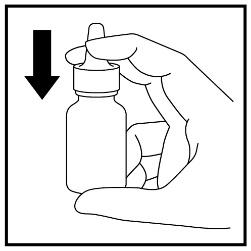
Figure 1
If the aerosol has not been used for 14 days or more, check its operation by pressing the bottle 2 times until a fine mist is obtained.
How long the packaging of the medicine will last
If you use two doses of the nasal spray in each nostril once a day, the medicine will be enough for 15 days of treatment (for bottles containing 60 measured doses) or for 30 days (for bottles containing 120 measured doses) or for 35 days (for bottles containing 140 measured doses).
How to use the nasal spray
- 1. Shake the bottle vigorously and remove the cap (Figure 2).
- 2. Gently blow your nose.
- 3. Close one nostril and insert the tip of the dispenser into the other nostril, as shown in the picture (Figure 3). Tilt your head slightly forward, holding the bottle upright. The tip of the dispenser should be pointed towards the nostril and not towards the nasal septum.
| Cap Tip of the dispenser Bottle | Figure 2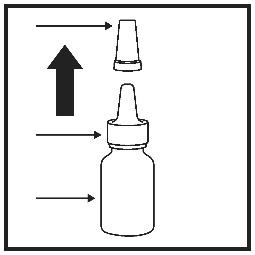 |
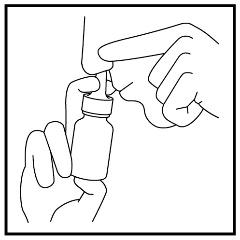
Figure 3
- 4. Start slow inhalation through the nose, during which you should spray the aerosol in the form of a fine mist into the nose, pressing ONCEdown with your fingers (Figure 4).
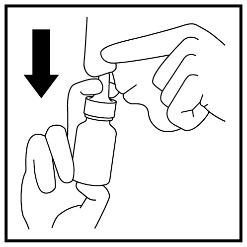
Figure 4
- 5. Exhale through the mouth, then repeat the actions described in point 4 to administer a second dose of the aerosol to the same nostril, if necessary.
- 6. Remove the tip of the dispenser from the nostril and exhale through the mouth.
- 7. Repeat the actions described in points 3-6 to administer the aerosol to the other nostril (Figure 5).
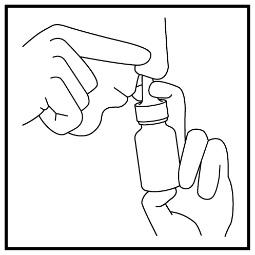
Figure 5
After using the aerosol, gently wipe the tip of the dispenser with a clean tissue or cloth and put the cap back on to prevent dust from entering.
Cleaning the nasal spray bottle
- The nasal spray bottle should be cleaned regularly, as it may not work properly otherwise.
- Remove the cap (Figure 6) and gently pull off the tip of the dispenser (Figure 7).
| Cap | Figure 6 | Tip of the dispenser | Figure 7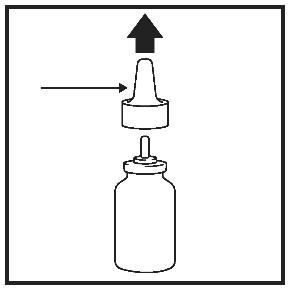 |
- Wash the cap (Figure 8) and the tip of the dispenser (Figure 9) in warm water, then rinse under running water.
| Cap | Figure 8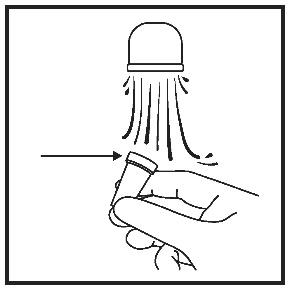 | Tip of the dispenser | Figure 9 |
- Do not try to unblock the nasal applicator by inserting a pin or other sharp object, as this may damage the applicator and prevent you from receiving the correct dose of the medicine.
- Leave the protective cap and the tip of the dispenser in a warm place to dry.
- Put the tip of the dispenser back on the bottle (Figure 10), then put the cap back on (Figure 11).
| Central hole Tip of the dispenser Spraying system | Figure 10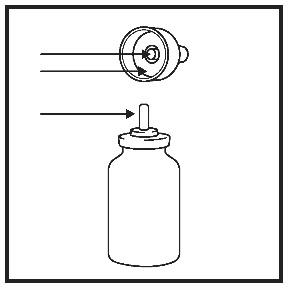 | Figure 11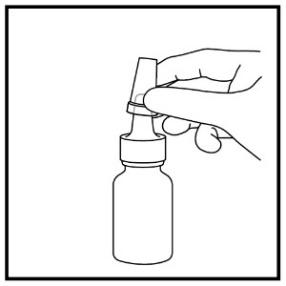 |
- After cleaning, check if the dispenser is working properly and spray the aerosol 2 times (Figure 12).
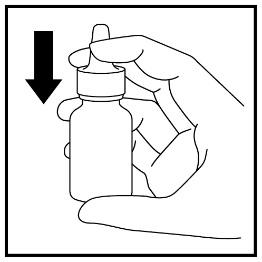
Figure 12
Using a higher dose of Pronasal Control than recommended
Consult your doctor if you have accidentally used a higher dose of the medicine than recommended.
If steroids are used for a long period or in high doses, they may have an adverse effect on the patient's hormones in rare cases. In children, they may affect growth and development.
Missing a dose of Pronasal Control
If you forget to use the nasal spray at the usual time, use it as soon as you remember, and then continue treatment at the usual time. Do not use a double dose to make up for the missed dose.
Stopping treatment with Pronasal Control
In some patients, improvement occurs within 12 hours of administering the first dose of Pronasal Control, although the full benefits of treatment may not be observed until after 2 days of treatment. It is very important that you use the nasal spray regularly. Do not stop treatment, even if you feel better, unless your doctor has explicitly advised you to do so.
In case of any further doubts about the use of the medicine, consult your doctor or pharmacist.
4. Possible side effects
Like all medicines, this medicine can cause side effects, although not everybody gets them.
After using the medicine, immediate allergic reactions (hypersensitivity) may occur. These reactions can be severe. Stop using Pronasal Control and seek medical attention immediately if you experience symptoms such as:
- swelling of the face, tongue, or throat
- difficulty swallowing
- hives
- wheezing or difficulty breathing.
If corticosteroids in the form of a nasal spray are taken in high doses for a long time, side effects may occur due to the absorption of the medicine into the body.
Other side effects
Most people do not report any side effects after using the nasal spray. However, some people have reported the following side effects after using Pronasal Control or another corticosteroid nasal spray:
Common side effects (may affect up to 1 in 10 people):
- headache
- sneezing and irritation/burning of the nasal mucosa
- nasal bleeding [very common (may affect more than 1 in 10 people) in patients with nasal polyps who used two doses of Pronasal Control in each nostril twice a day]
- nasal or throat pain
- ulceration of the nasal mucosa
- upper respiratory tract infection
Frequency not known (frequency cannot be estimated from the available data):
- increased intraocular pressure (glaucoma) and/or cataract causing vision disturbances
- damage to the nasal septum separating the nostrils
- disturbances of taste and smell
- difficulty breathing and/or wheezing
- blurred vision
Reporting side effects
If you experience any side effects, including any possible side effects not listed in the leaflet, tell your doctor, pharmacist, or nurse. Side effects can be reported directly to the Department of Adverse Reaction Monitoring of Medicinal Products, Medical Devices, and Biocidal Products, Al. Jerozolimskie 181C, 02-222 Warsaw
Phone: +48 22 49 21 301
Fax: +48 22 49 21 309
Website: https://smz.ezdrowie.gov.pl
Side effects can also be reported to the marketing authorization holder.
By reporting side effects, you can help provide more information on the safety of this medicine.
5. How to store Pronasal Control
Keep the medicine out of the sight and reach of children.
Do not use this medicine after the expiry date stated on the bottle and carton after: {Expiry date (EXP):} or {EXP:}. The expiry date refers to the last day of the month.
Do not store above 25°C. Do not freeze.
Shelf life after first opening: 8 weeks
Medicines should not be disposed of via wastewater or household waste. Ask your pharmacist how to dispose of medicines that are no longer required. This will help protect the environment.
6. Contents of the packaging and other information
What Pronasal Control contains
- The active substance of the medicine is mometasone furoate. Each dose of the medicine (0.1 ml) contains 50 micrograms of mometasone furoate (as mometasone furoate monohydrate). The total mass of one dose is 100 mg.
- The other ingredients are: microcrystalline cellulose and sodium carmellose (Avicel RC-591), glycerol, benzalkonium chloride, polysorbate 80, citric acid monohydrate, sodium citrate, water for injections.
What Pronasal Control looks like and what the pack contains
Pronasal Control is a nasal spray, suspension.
Each bottle contains 60, 120, or 140 doses of the medicine.
Not all pack sizes may be marketed.
Marketing authorization holder and manufacturer
Marketing authorization holder:
Teva B.V.
Swensweg 5
2031 GA Haarlem
Netherlands
Manufacturer:
Teva Czech Industries s.r.o.
Ostravská 305/29, Komárov, 747 70 Opava,
Czech Republic
Merckle GmbH
Ludwig-Merckle-Str.3
89143 Blaubeuren
Germany
To obtain more detailed information about the medicine, contact the representative of the marketing authorization holder:
Teva Pharmaceuticals Polska Sp. z o.o.
ul. Emilii Plater 53
00-113 Warsaw
Phone: (22) 345 93 00
This medicine is authorized in the Member States of the European Economic Area under the following names:
Belgium: Mometeva 50 microgram/verstuiving, neusspray, suspensie
Germany: Mometason-ratiopharm Heuschnupfenspray
Poland: Pronasal Control
Detailed and up-to-date information about this medicine is available after scanning the QR code on the leaflet with a smartphone. The same information is also available on the website:
http://tevamed.pl/tevamed/Materialy_edukacyjne/Pronasal_Control-
material_edukacyjny_dla_pacjenta.pdf
Date of last revision of the leaflet: February 2024
2D
- Country of registration
- Active substance
- Prescription requiredNo
- ImporterMerckle GmbH Teva Czech Industries s.r.o.
- This information is for reference only and does not constitute medical advice. Always consult a licensed doctor before taking any medication. Oladoctor is not responsible for medical decisions based on this content.
- Alternatives to Pronasal ControlDosage form: Aerosol, 50 mcg/doseActive substance: mometasoneManufacturer: FARMEA US Pharmacia Sp. z o.o.Prescription not requiredDosage form: Aerosol, 50 mcg/doseActive substance: mometasoneManufacturer: FarmeaPrescription requiredDosage form: Aerosol, 50 mcg/doseActive substance: mometasoneManufacturer: Adamed Pharma S.A. FarmeaPrescription not required
Alternatives to Pronasal Control in other countries
The best alternatives with the same active ingredient and therapeutic effect.
Alternative to Pronasal Control in Spain
Alternative to Pronasal Control in Ukraine
Online doctors for Pronasal Control
Discuss dosage, side effects, interactions, contraindications, and prescription renewal for Pronasal Control – subject to medical assessment and local rules.








